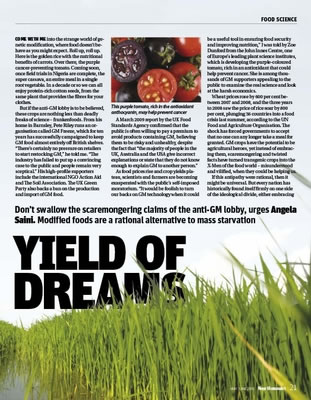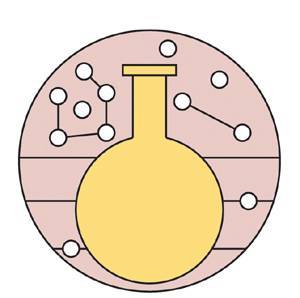 Come with me into the strange world of genetic modification, where food doesn't behave as you might expect. Roll up, roll up. Here is the golden rice with the nutritional benefits of carrots. Over there, the purple cancer-preventing tomato. Coming soon, once field trials in Nigeria are complete, the super cassava, an entire meal in a single root vegetable. In a decade or so we can all enjoy protein-rich cotton seeds, from the same plant that provides the fibres for your clothes.
Come with me into the strange world of genetic modification, where food doesn't behave as you might expect. Roll up, roll up. Here is the golden rice with the nutritional benefits of carrots. Over there, the purple cancer-preventing tomato. Coming soon, once field trials in Nigeria are complete, the super cassava, an entire meal in a single root vegetable. In a decade or so we can all enjoy protein-rich cotton seeds, from the same plant that provides the fibres for your clothes.
But if the anti-GM lobby is to be believed, these crops are nothing less than deadly freaks of science - frankenfoods. From his home in Barnsley, Pete Riley runs an organisation called GM Freeze, which for ten years has successfully campaigned to keep GM food almost entirely off British shelves. "There's certainly no pressure on retailers to start restocking GM," he told me. "The industry has failed to put up a convincing case to the public and people remain very sceptical." His high-profile supporters include the international NGO Action Aid and The Soil Association. The UK Green Party also backs a ban on the production and import of GM food.
A March 2009 report by the UK Food Standards Agency confirmed that the public is often willing to pay a premium to avoid products containing GM, believing them to be risky and unhealthy, despite the fact that "the majority of people in the UK, Australia and the USA give incorrect explanations or state that they do not know enough to explain GM to another person."
As food prices rise and crop yields plateau, scientists and farmers are becoming exasperated with the public's self-imposed moratorium. "It would be foolish to turn our backs on GM technology when it could be a useful tool in ensuring food security and improving nutrition," I was told by Zoe Dunford from the John Innes Centre, one of Europe's leading plant science institutes, which is developing the purple-coloured tomato, rich in an antioxidant that could help prevent cancer. She is among thousands of GM supporters appealing to the public to examine the real science and look at the harsh economics.
Wheat prices rose by 600 per cent between 2007 and 2008, and the three years to 2008 saw the price of rice soar by 800 per cent, plunging 36 countries into a food crisis last summer, according to the UN Food and Agriculture Organisation. The shock has forced governments to accept that no one can any longer take a meal for granted. GM crops have the potential to be agricultural heroes, yet instead of embracing them, scaremongering and twisted facts have turned transgenic crops into the X-Men of the food world - misunderstood and vilified, when they could be helping us.
If this antipathy were rational, then it might be universal. But every nation has historically found itself firmly on one side of the ideological divide, either embracing genetic modification or banning it wholesale. The United States, for example, is the world's most GM-friendly place, growing modified crops on nearly 60 million hectares of land. According to Department of Agriculture statistics from June 2008, almost every soybean grown the US is a GM variety - and likely to be found in such American family favourites as Hershey's chocolate bar and the beloved crème-filled Twinkie.
 Asia has also invested heavily in GM. In India, where farmers grew 31 million bales of modified cotton last year, the government is soon likely to approve a GM aubergine. China, which also grows large amounts of GM cotton, is planning to introduce domestically-developed varieties of GM rice. Research in both these countries, as well as South Africa and the Philippines, shows that biotech crops have increased incomes by between £80 and £170 for every hectare on which they are grown, according to the International Service for the Acquisition of Agri-Biotech Applications (ISAAA).
Asia has also invested heavily in GM. In India, where farmers grew 31 million bales of modified cotton last year, the government is soon likely to approve a GM aubergine. China, which also grows large amounts of GM cotton, is planning to introduce domestically-developed varieties of GM rice. Research in both these countries, as well as South Africa and the Philippines, shows that biotech crops have increased incomes by between £80 and £170 for every hectare on which they are grown, according to the International Service for the Acquisition of Agri-Biotech Applications (ISAAA).
In the decade from 1996, the ISAAA reports that biotech crops saved farmers from using 359,000 tonnes of pesticides worldwide. In all, the 25 countries that permit GM crops are now growing them commercially on an area of land equivalent to five times the size of the UK.
But nearer home the total remains zero. While our American and Asian neighbours munch away on GM cuisine, only one crop is allowed inside the European Union - a strain of insect-resistant maize known as Mon810 - and only seven countries grow it. Since 1997, GM foods have also been strictly labelled, which means, bizarrely, if you were to visit New York as a tourist it is likely that you would eat GM food daily without even realising it, and yet in London you cannot even buy a tin of GM tomatoes without a warning label.
"GM crops are a perfect example of a scientific uncertainty," explained Dr Duncan French, an expert in environmental law at the University of Sheffield. "They could have great economic and social benefits, but they also carry some risks." Until now, these risks have allowed European governments to adopt the precautionary principle; avoiding the GM dilemma in the happy knowledge that food grown by conventional means would not run out. Their dismal failure to inform people about GM crops has given green groups and biotech corporations the chance to hijack the agenda, leaving consumers with the impression that the science is far more controversial than it really is.
The Royal Society stated back in 2003 that there is no evidence that GM foods are inherently less safe than non-GM foods. Most experts will tell you: Yes, GM foods can offer nutritional benefits and better yields than existing crops. But, no, we don't know whether a new modified crop is completely safe until it is tested, in the same way as scientists cannot predict how any new plant variety will interact with the environment or with our bodies without carrying out research.
GM crops are developed by slightly changing a plant's DNA, which is the genetic material that defines its function. Gene splicing, as it is known, takes a gene from the DNA of one organism and puts it in another. Golden rice, for example, was created by inserting two genes that help the grain produce and keep extra amounts of beta-carotene, which is a form of Vitamin A most commonly found in carrots. Since all these genes exist naturally, there is no reason why modified plant DNA would pose extra risk to our bodies, especially since the bulk of it is broken down in our stomachs anyway.
All GM crops grown commercially have been tested to ensure they are safe. Nevertheless, green activists and consumer groups have so successfully exploited pseudoscientific myths that they are now routinely referred to as "frankenfoods". Some have even managed to launch a campaign in favour of GM labelling in the United States, whipping up fear where little existed before - a recent Soil Association report celebrated a "growing consumer rejection of GM foods in America".
 Jeff Rooker, former Food and Farming Minister, went so far as to warn a Labour Party conference fringe meeting last autumn that anti-GM groups "are on a messianic mission, it is like a religion, but there is no science base to it." But that is not to say that these activists don't sometimes have a point. For example, when I asked Friends of the Earth's food campaigner, Clare Oxborrow, what her alternatives to GM would be, some of her ideas made good sense - rearing meat is inefficient, so it would help food supplies if countries were to shift the balance towards more vegetables and cereals. But there are few other ideas that are workable on the kind of scale that is needed to feed the world. "We would support more localised systems of agriculture," Oxborrow told me, suggesting that farmers in the developing world should revert to subsistence farming.
Jeff Rooker, former Food and Farming Minister, went so far as to warn a Labour Party conference fringe meeting last autumn that anti-GM groups "are on a messianic mission, it is like a religion, but there is no science base to it." But that is not to say that these activists don't sometimes have a point. For example, when I asked Friends of the Earth's food campaigner, Clare Oxborrow, what her alternatives to GM would be, some of her ideas made good sense - rearing meat is inefficient, so it would help food supplies if countries were to shift the balance towards more vegetables and cereals. But there are few other ideas that are workable on the kind of scale that is needed to feed the world. "We would support more localised systems of agriculture," Oxborrow told me, suggesting that farmers in the developing world should revert to subsistence farming.
On the other side of the debate, defensive biotech companies have spent millions on vigorously slick PR campaigns that have done little more than leave the public more frightened. In 2005, Monsanto, the world's largest food biotechnology company, was fined almost £800,000 for bribing an Indonesian official to prevent an environmental study on one of its crops. The firm has been widely accused of heavy-handed patent enforcement and intimidation.
Occupying the rational middle ground, meanwhile, are scientists and farmers with the argument that, while GM is not a panacea, it could help raise yields and improve the nutritional value of what we eat. Such is the desire for more productive plants that a farmer in Wales recently admitted that he had been growing two varieties of modified maize, in defiance of a Welsh Assembly Government vote to keep the country GM-free.
According to Andrew Clark from the National Farmers' Union, Europe's GM policy is making it harder for farmers to compete in global markets. "It's virtually impossible in the rest of the world to guarantee zero GM contamination, particularly in soya and maize. Increasingly this is becoming an economic concern, for example, for European livestock farmers who can't buy animal feed."
"Farmers seem to have been left out of the debate," added Prof Andy Lane from the Open University. In 2008, he surveyed 30 large-scale commodity crop farmers and found them generally supportive of GM. "Those we interviewed thought GM crops had something to offer. For them, because they had been involved in whole swathes of new technologies and plant varieties, they didn't see GM as significantly different from traditional plant breeding."
After all, before food entered the laboratory, farmers tinkered with crops and animal breeds for generations, to the point where many no longer resemble wild varieties. The common carrot, for example, used to be yellow until Dutch horticulturalists in the 17th century, keen to create a vegetable to match their royal banner, crossed generations of carrots until they had bred a bright orange one. Genetic engineering represents just another technological step in the journey of our food.
But hunger, rather than science, may be what changes minds in the end. Ravaged by last year's food shortages, Africa, which has traditionally been hostile to GM crops, has now slowly begun to accept their benefits. In February, Kenya became the fourth African country to allow the production and use of GM crops, and researchers in Cape Town are now working on a type of maize that is resistant to the deadly maize streak virus. Maybe even Europe will start to find golden rice and purple tomatoes more appetising, when the alternative is no food at all.

